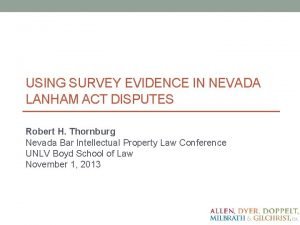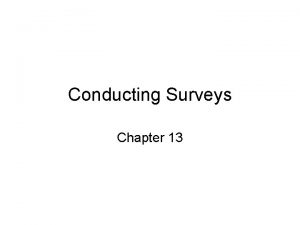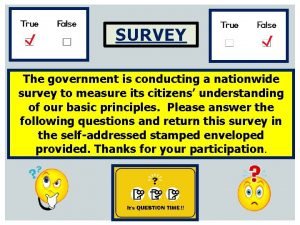Conducting Concerns Surveys What is a concerns survey













- Slides: 13

Conducting Concerns Surveys

What is a concerns survey? A survey in which citizens identify the most important issues facing their community.

Results can then be used to: • help form strategies to deal with community problems • maintain things that work • rally the community around a cause • build consensus

Why conduct a concerns survey? • You should start off with people's concerns • It involves community members in the decision-making process early on • It's a useful source of information for initiatives, funders, and participants • It's easy to do • It helps set the work agenda • It builds consensus

Who should you survey? As many local people as possible!

How to prepare a concerns survey: 1. Consider budget & resources 2. Put together a working group to design the survey 3. Invite selected decision makers to submit additional survey items 4. Prepare a 30 -item survey with additional demographic info

How to prepare a concerns survey (cont. ): For every selected issue ask: • how important the issue is to citizens? • how satisfied citizens are with community efforts on the issue?

Distributing a concerns survey Direct mail is most common. Other methods: • Drop boxes • Media distribution • Convenience sampling • Group administration • Door-to-door canvassing You may also want to consider using multiple methods of distribution

Collecting the surveys: 1. Gather incoming surveys collected at participating sites 2. Review returned surveys 3. Secure a larger return, if necessary

Analyzing and Compiling the Results: 1. Average the importance & satisfaction for each item 2. Rank items according to the ones that have the highest percentages of importance a. Strengths: high ratings in both importance and satisfaction b. Problems: rated high in importance but low satisfaction

Analyzing and Compiling the Results: 3. Write up a brief report summarizing strengths, problems, and overall approval rating a. Identify five to ten strengths and five to ten problems 4. Share the above information with your staff.

What next? Conduct a public meeting: • Review main strengths & problems • Lead separate discussions on each issue • Afterwards, write a one-page narrative for each issue discussed

Prepare a concerns report Should consist of: • Executive memo • Brief report • Data table • Discussion report • Demographic data & other displays • Suggestions on how to use the report in the planning process
 Surveys experiments and observational studies 8-3 answers
Surveys experiments and observational studies 8-3 answers 叫叫abcde
叫叫abcde Real eyes surveys
Real eyes surveys Webrds
Webrds Cadastral surveys
Cadastral surveys Literature survey in research
Literature survey in research Togus pond maine water quality
Togus pond maine water quality Lesson 3.5 sampling and surveys
Lesson 3.5 sampling and surveys Www ons gov uk surveys
Www ons gov uk surveys Biased and unbiased samples
Biased and unbiased samples The enacted curriculum
The enacted curriculum Paid surveys slovenia
Paid surveys slovenia Surveys.panoramaed.com/everett
Surveys.panoramaed.com/everett Lanham act surveys
Lanham act surveys

























